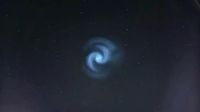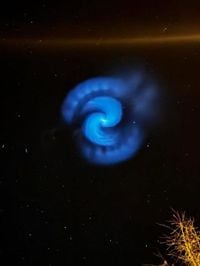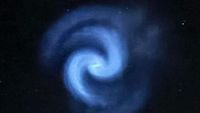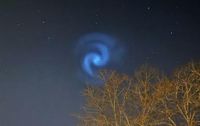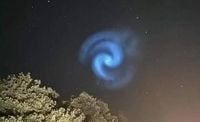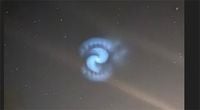On the night of March 24 to 25, 2025, a wondrous blue spiral graced the skies above Vendée, France, and several other regions, captivating observers and sparking a multitude of questions. The spirals were a phenomenon that many viewers captured and shared through photographs on social media, generating excitement and curiosity among the public.
The enchanting display was first noted around 21:00 on March 24, 2025, with reports flooding in from various areas, particularly from Charente where it was described as a pale blue and white luminous spiral. Many observers were quick to post their observations online, with amateur astronomer Eric Barbotin being one of the key figures explaining the event.
Unlike typical celestial displays like meteors or auroras, this spiral was confirmed to be the result of significant rocket activity. It originated from the Falcon 9 rocket launched by SpaceX from Cape Canaveral at 17:48 UTC (18:48 local time in Nice). Reports indicated that the first stage of the Falcon 9 rocket had vented fuel into space after its launch, creating the visually striking spiral visible across much of France as well as in other European countries.
Charentaise residents shared numerous accounts of the phenomenon between 20:55 and 21:10 on that fateful night. “It was a sudden, mobile form that appeared in the sky—it caught many of us off guard,” said Lucas Vieira, a local observer. The images shared show vibrant colors and bright luminescence, contrasting starkly against the dark evening sky.
Barbotin emphasized that the spirals happened as a result of the rocket's fuel being expelled and subsequently freezing in the upper atmosphere, reflecting sunlight and creating an eye-catching spectacle. “The gases are ejected asymmetrically, freezing almost instantly but still reflecting light from the sun, resulting in the spirals we observed,” he explained.
In addition to the technical details, Barbotin noted that such occurrences are relatively rare and highlighted that the launch of the NROL-69 satellite, an American spy satellite, was designed specifically to have a trajectory that would allow it to be visible over parts of Europe. The timing of the launch, coinciding with the spring equinox, increased visibility due to the angle of sunlight, which allowed for this rare occurrence to delight spectators.
Several photographs shared on social networks reflected the excitement of the evening. Digital platforms lit up with appreciative comments and questions from people trying to understand whether they had witnessed an alien encounter, as the sight was unusual and striking. “My friends and I thought it was something mysterious,” said a resident from Taponnat, who captured the moment on camera. “When I learned it was from a rocket, I was both relieved and fascinated.”
In addition to Charente and Vendée, observers as far north as the Vosges also reported the phenomenon, which spanned across the length of France. The spread of sightings prompted further investigation and articulation from scientific circles. Météo Côte-d'Azur reported on the phenomenon shortly after it gained traction, reinforcing Barbotin's claims of the fuel expulsion causing the luminous spirals in the sky.
While this blue spiral astonished many, it was not the first time such a sight has been recorded. Back in 2023, similar phenomena were witnessed in places like New Zealand, Hawaii, and Alaska, which were also attributed to rocket launches by SpaceX. The repetition of such events points to the increasing visibility of satellite action above Earth, funded by advancements in technology and the quest for space exploration, led by companies like SpaceX.
As France continues to explore its place in the advances of space technology, public interest in such extraordinary occurrences only seems to grow. During such launches, the intersection between technology and public spectacle creates a beautiful blending of curiosity and fear, reflecting our fascination with the unknown. Reminiscing about the night of March 24 leads many to wonder what they’ll see next with the ever-evolving world of space exploration.
Barbotin reminded the public that while such moments invoke intrigue, they are firmly rooted in scientific principles, reminding everyone that the skies hold an abundance of wonders waiting to be explored. “We can expect to see more of this,” he says, optimistic about the future of space missions. “With more technological advances, opportunities for breathtaking displays are likely to increase.”
As more launches occur, the awareness of their impact on our atmosphere and planet will grow. It opens a dialogue among observers and scientists about the balance between innovation in space technology and its observable effects on Earth. Science will continue to unravel the cosmos, but it’s vital for the public to understand the origins of these awe-inspiring displays.
In the end, the blue spiral was a reminder of our technological capabilities and the beauty in both our planet and the universe beyond it—a significant moment captured in the love of space by communities across France.
